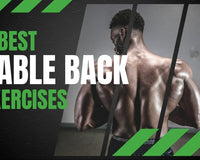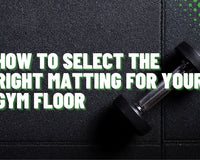You can foam roll till the cows come home, but if your calf muscles still feel like steel cables, it’s time for a smarter plan.
That said, training your calves and releasing that tightness is totally doable. Give them the right combo of warm up, mobility, strength, recovery, and smart habits, and they repay you with springy steps and happier squats. Let’s loosen up those calves!
An Introduction to Your Calves

The gastrocnemius is the larger two headed muscle that pops when you point your toes. The soleus sits underneath and works hard any time your knee is bent, like when you walk, stand from a chair, or hold the bottom of a squat.
Together they attach to the Achilles tendon, which anchors to your heel bone. These muscles push you forward when you run, help you jump, and even help your veins move blood back up the leg.
Because they do so much, calves can feel tight for many reasons. Sometimes the workload jumps too fast. Sometimes shoes shorten your range of motion. Desk days keep ankles frozen in one angle. Other times, hydration, minerals, or medications are involved.
Related Post: Best Exercises to Grow Your Calves
How Tight Calves Usually Feel
Tightness can show up as a pulling sensation during a squat or lunge, a stubborn heel lift at the bottom of a squat, or a cramp that grabs during a run or while pointing your toes in bed.
The muscle may feel firm, twitch a little, or protest when you press on it. Cramps might last seconds or stubborn minutes. After hard sessions, soreness can arrive right away or sneak in hours later.
You might also notice
-
A pinch behind the knee when you push the toes down under resistance
-
Trouble getting onto the balls of your feet without discomfort
-
Swelling or bruising after a strain or minor tear
Why Calves Get Tight
Understanding the cause makes your fix stick. Here are the usual suspects, and how they connect.

Training Spikes
You signed up for a race, then doubled your weekly miles. Or you added box jumps and hill sprints in the same week. Your calves notice.
Shoes and Surfaces
High heels keep ankles pointed for hours. Stiff soles block the smooth roll from heel to toe. Hard ground during long sessions also adds impact that calves must absorb.
Desk Life and Car Time
When you sit, your knee and ankle barely move. Over time, your brain learns that a small range is the new normal. Then a deep squat or sprint feels like asking a sleepy door hinge to swing wide without oil.
Hydration And Minerals
Cramps love dry muscles. Water helps, and so do minerals like sodium, potassium, calcium, and magnesium. No need to turn your kitchen into a chemistry lab. Just cover the basics, which we will detail later.
Structural Limits and Old Injuries
Past ankle sprains, scar tissue, or bony changes can restrict dorsiflexion. You can still improve, but you need patience and a plan that pairs mobility with strength so gains last.
Quick Self Checks You Can Try
Simple screens help you decide where to focus.
-
Knee To Wall Test: Stand facing a wall. Place one foot flat with the big toe a few centimeters away. Keep the heel down and gently drive the knee toward the wall. Scoot the foot back until the knee just touches without the heel lifting. Compare sides. Less motion on one side points to a target for mobility and strength.
-
Bodyweight Squat with Heels Down: Squat slowly with feet hip width and heels planted. If the heels pop up or the torso has to tip too far forward, your calves and ankles want attention.
-
Single Leg Calf Raise Quality: Stand on one foot, fingertip support on a wall. Rise to your highest tiptoe in a smooth four second up and four second down. Aim for ten to fifteen good reps. If the end range is weak or shaky, your strength work will pay big dividends.
Now that you know your starting point, let us build the plan.
A Good Calf Warmup

Before stretching or strength, bring blood flow and gentle movement. This makes everything feel better and protects against cranky reactions.
-
Two to Three Minutes of Easy Marching: Lift knees, swing arms, breathe.
-
Ankle Circles: Ten slow circles each direction per ankle. Move from the ankle, not the hip.
-
Toe Walks and Heel Walks: Ten meters on toes, then ten on heels. Think quiet feet.
-
Mini Pogo Hops: Twenty light hops in place to teach spring without pounding.
Stretching your Calves
Stretching can reduce that tight feeling and improve range of motion, especially when your tightness comes from sitting or repetitive training.
Straight Knee Wall Calf Stretch
-
Stand with one foot forward and one back
-
Keep the back knee straight and the heel down
-
Lean toward the wall until you feel a stretch in the upper calf
-
Hold twenty to thirty seconds and breathe slowly
-
Switch legs and complete three rounds per side

Bent Knee Wall Calf Stretch
-
Use the same stance as above
-
Bend the back knee while keeping the heel down
-
Lean forward until you feel the stretch lower in the calf and around the Achilles
-
Hold twenty to thirty seconds
-
Switch legs and complete three rounds per side
Step Drops
-
Stand on a step on the balls of both feet with heels in the air
-
Slowly lower both heels below the step until you feel a stretch
-
Hold twenty to thirty seconds
-
Rise back to neutral with support from the railing
-
Repeat for three rounds
Downward Dog Pedal
-
From hands and feet, lift hips to make an upside down V
-
Press one heel toward the floor while the other knee bends
-
Slowly alternate for twenty to thirty total pedals
-
Keep shoulders relaxed away from ears
Why Strength Is The Secret Sauce
Stretching opens the door. Strength keeps it from closing. When you add controlled calf raises, your muscles build more contractile units in series, which is a fancy way of saying the muscle gets longer and stronger.
Standing Straight Knee Calf Raises

-
Stand on a step so your heels can drop below the forefoot
-
Use light fingertip support for balance
-
Rise up on the balls of your feet over four seconds
-
Pause for one second at the top
-
Lower over four seconds to a comfortable stretch
-
Keep the weight centered over the big toe and second toe
-
Start with two sets of ten to fifteen reps
If it’s too easy after a week or two, try single leg. Aim for two sets of eight to twelve steady reps per side. If you still breeze through, hold a dumbbell in the same side hand.
Bent Knee Calf Raises For Soleus
-
Set up on the same step
-
Slight knee bend about a quarter squat
-
Hold that knee angle while the ankle moves
-
Rise for four seconds, pause, then lower for four
-
Two sets of ten to fifteen reps
Seated versions are great if your quads fatigue. Place the balls of your feet on a sturdy block, rest a weight on your thighs, then use the same slow tempo.
Isometric Holds For Extra Stubborn Calves
Isometrics calm sensitive tendons and build endurance.
-
Rise to a strong tiptoe and hold for twenty to thirty seconds
-
Lower slowly and rest for twenty seconds
-
Repeat three to five times
Alternate isometric days with the raising and lowering days, or tuck them in after your usual sets.
How Often Should You Strengthen?
Most people do best with three nonconsecutive days each week. For example, Monday, Wednesday, and Friday. Pick two to three of the moves above, keep total working sets around six to nine, and use the slow tempo. After four to eight weeks, you can taper to two days per week for maintenance.
Soft Tissue Work for Your Calves
Strength is the long term fix, yet your calves will love a little pampering while you build capacity.
Foam Rolling Flow

-
Sit with the roller under one calf
-
Lift your hips with your hands and slowly roll from just above the Achilles to just below the knee
-
When you find a tender patch, stop and breathe for twenty to thirty seconds
-
Gently flex and point the ankle five to eight times while you stay on that spot
-
Spend one to two minutes per calf
Contrast Temperature For Relief
If the muscle feels angry after hard work, use the classic RICE approach for forty-eight to seventy-two hours. Rest for fifteen to twenty minutes per session, comfortable compression, and leg elevation.
After that early window, many people enjoy gentle heat before mobility and ice after if soreness lingers.
Shoe Smarts and Foot Care
Match footwear to your training. A flexible forefoot helps the foot roll smoothly from heel to toe. Retire beat-up shoes before the cushion and structure are gone.
If you wear high heels, add regular flat time during the day and stretch calves after you change. If your Achilles is picky, avoid sudden changes to very minimal shoes. Gradual change keeps the peace.
A Two-Week Calf Reset Plan
Here is a sample schedule to put it all together. Tweak to your training days.
Daily
Warm up flow for five minutes, then either the stretch block or the strength block, followed by two minutes of foam rolling.
Strength block three days per week
-
Standing straight knee calf raises two sets of ten to fifteen
-
Bent knee calf raises two sets of ten to fifteen
-
Tiptoe holds three times thirty seconds
Stretch block two to four days per week
-
Straight knee wall stretch three holds of thirty seconds each side
-
Bent knee wall stretch three holds of thirty seconds each side
-
Step drops two holds of thirty seconds
Hydration and nutrition
-
Water at each meal and one bottle during training
-
One fruit and one leafy or dairy source daily
-
Salt to taste unless your clinician advised otherwise
After two weeks, reassess your knee-to-wall test and your single-leg calf raise quality. You should notice a smoother squat, better comfort on runs, and fewer mid foot cramps. Keep the program going for at least six to eight weeks for progress.
Sport Specific Notes

Here are some notes and tips about tight calves for specific types of athletes.
Runners
Keep hard runs away from heavy calf days. If you strength train on Monday, plan your speed session on Tuesday or Wednesday. For hills, add a little extra bent knee work to be kind to the soleus. If you add mileage, cap the weekly jump to a modest amount so your calves can adapt.
Lifters
Poor ankle motion gets blamed on hips, then squats get ugly. Use the warm up flow before squats, then plug in two sets of straight knee calf raises after your main lifts. Heels down during goblets and front squats will feel more natural within a few weeks.
Court and Field Athletes
Your calves are your springs. Keep the pogo hops in your warm up. Land quietly. Finish practice days with light foam rolling and a quick bent knee stretch while chatting with teammates.
When Stretching Alone Is Not Enough
You might have seen spirited debates about stretching. Some folks swear by long holds. Others say stretching never changed anything except the clock. The truth sits in the middle. Stretching can feel great and improve motion for many people. For lasting change with fewer grumpy flare-ups, pair those stretches with strength and smart loading. Think of stretching as opening a door, and strength as placing a wedge so the door stays open.
Prevention Habits That Keep Tightness Away
Here are some tips to keep calf tightness at bay:
-
Warm up before you train and cool down with a light stretch
-
Progress training volume in small steps
-
Rotate shoes if you do many sessions each week
-
Keep water and mineral rich foods in your routine
-
Set a reminder to stand and move your ankles during long desk blocks
-
Maintain your strength work twice weekly even when the calves feel perfect
The Bottom Line on Tight Calves
Tight calves can bench your best plans. Thankfully they also respond fast when you feed them the right inputs. Start with a brief warm up, then stretch with intention. Follow with slow, controlled calf raises to tell the muscle to keep that new range. Roll a little to soothe the grumbly bits. Drink water, eat mineral rich foods, wear shoes that match your training, and ramp volume with care. Keep it going for a few weeks and enjoy the payoff each time you walk, run, or squat.





